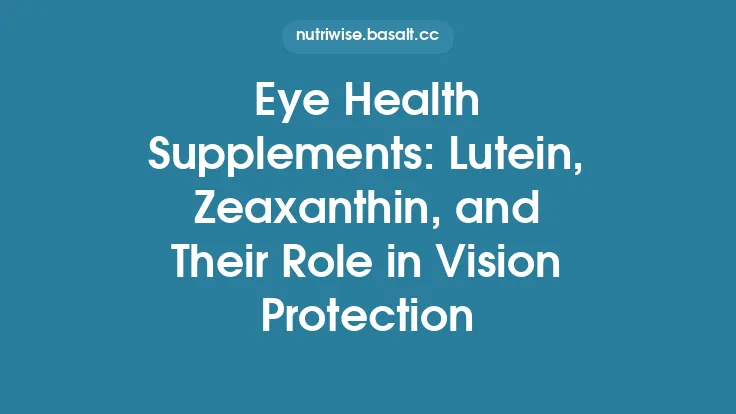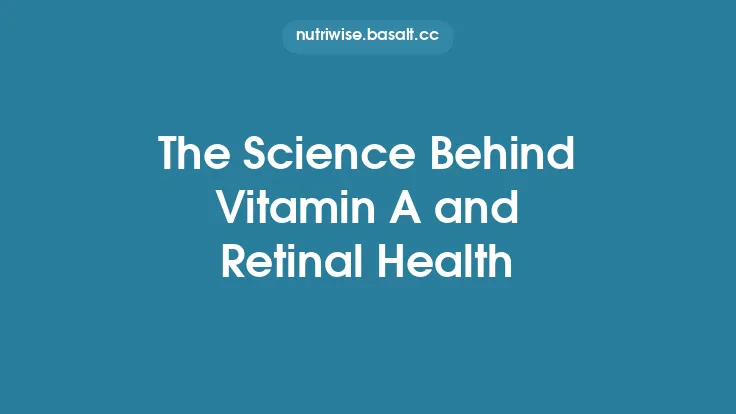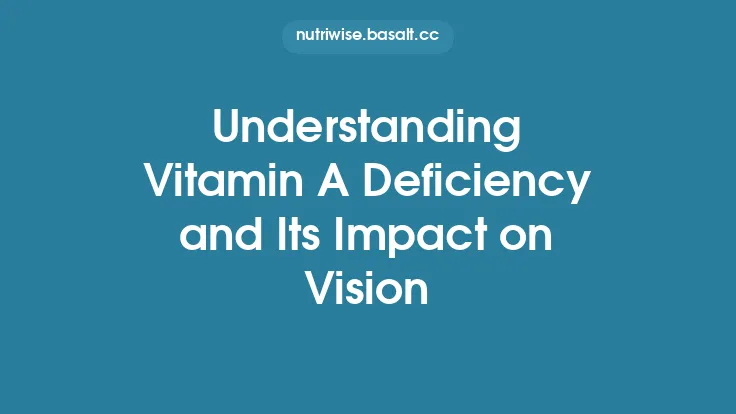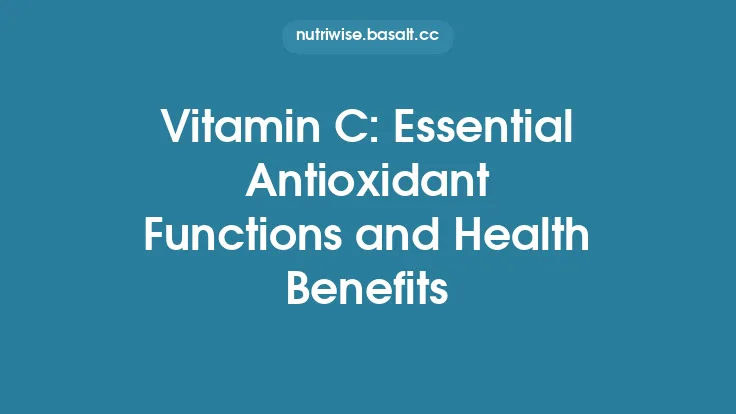Age‑Related Macular Degeneration (AMD) is the leading cause of irreversible central vision loss in older adults worldwide. While genetics, smoking, and overall diet are well‑established contributors, a growing body of research points to vitamin A and its metabolites as modulators of the disease’s onset and progression. This article examines the biochemical pathways through which vitamin A influences macular health, reviews the epidemiological and interventional evidence linking vitamin A status to AMD risk, and outlines practical considerations for clinicians and individuals seeking to incorporate vitamin A–focused strategies into a comprehensive AMD‑prevention plan.
The Pathophysiology of AMD and Where Vitamin A Fits In
Retinal pigment epithelium (RPE) homeostasis
The RPE performs essential tasks such as phagocytosing shed photoreceptor outer segments, recycling visual pigments, and maintaining the blood‑retina barrier. Vitamin A, in the form of all‑trans‑retinol, is a substrate for the visual cycle, but beyond that it serves as a ligand for nuclear retinoic acid receptors (RARs) and retinoid X receptors (RXRs). Activation of these receptors regulates transcription of genes involved in:
- Antioxidant defenses – up‑regulation of superoxide dismutase (SOD), catalase, and glutathione peroxidase, which mitigate oxidative damage to RPE lipids and proteins.
- Lipid metabolism – modulation of peroxisome proliferator‑activated receptor‑γ (PPAR‑γ) pathways that influence the turnover of the high‑density lipoprotein‑rich drusen material that accumulates in early AMD.
- Inflammatory signaling – suppression of NF‑κB‑mediated cytokine production, reducing chronic low‑grade inflammation that drives complement activation in the macula.
Photoreceptor outer‑segment renewal
All‑trans‑retinal, derived from vitamin A, is essential for the regeneration of 11‑cis‑retinal, the chromophore that captures photons. Efficient visual‑cycle turnover reduces the accumulation of toxic bisretinoid by‑products such as A2E, a major component of lipofuscin that can photo‑oxidize and trigger RPE apoptosis. Adequate vitamin A availability therefore helps limit lipofuscin load, a recognized risk factor for AMD.
Interaction with the complement system
Genetic variants in complement factor H (CFH) markedly increase AMD susceptibility. Retinoic acid signaling has been shown in vitro to down‑regulate complement component C3 expression in RPE cells, suggesting a mechanistic link whereby sufficient vitamin A may temper complement‑mediated inflammation.
Epidemiological Evidence Linking Vitamin A Status to AMD Risk
| Study | Design | Population | Vitamin A Assessment | Main Findings |
|---|---|---|---|---|
| Age‑Related Eye Disease Study (AREDS) 2 (sub‑analysis) | Prospective cohort | 3,500 participants, 55–80 y | Serum retinol concentrations | Higher baseline serum retinol (≥ 1.2 µmol/L) associated with a 22 % lower incidence of progression to advanced AMD over 5 years (adjusted HR 0.78). |
| Rotterdam Study | Population‑based cohort | 4,800 adults ≥ 55 y | Dietary intake via FFQ + serum retinol | Participants in the highest quintile of vitamin A intake had a 30 % reduced odds of early AMD (OR 0.70) after controlling for smoking, BMI, and carotenoid intake. |
| Blue Mountains Eye Study | Cross‑sectional & longitudinal | 2,800 Australians | Serum retinol & dietary recall | Low serum retinol (< 0.7 µmol/L) correlated with a 1.5‑fold increased risk of incident neovascular AMD; effect persisted after adjusting for zinc and lutein/zeaxanthin. |
| Meta‑analysis (2021, 12 studies) | Systematic review & meta‑analysis | 23,000 participants | Combined serum and dietary data | Pooled relative risk for AMD in highest vs. lowest vitamin A exposure = 0.81 (95 % CI 0.73–0.90). Heterogeneity largely explained by differences in supplement formulation and baseline nutritional status. |
Collectively, these data suggest a modest but consistent protective association between higher vitamin A status and reduced AMD incidence or progression. Importantly, the protective signal remains after statistical adjustment for other micronutrients (e.g., lutein, zeaxanthin, zinc), indicating an independent contribution.
Clinical Trials of Vitamin A Supplementation for AMD Prevention
AREDS‑2 Formulation
The AREDS‑2 trial added lutein, zeaxanthin, and omega‑3 fatty acids to the original AREDS cocktail (vitamin C, vitamin E, β‑carotene, zinc, copper). While β‑carotene (a provitamin A) was removed for safety in smokers, a secondary analysis examined participants who continued low‑dose retinyl palmitate (10 000 IU/day) as part of a separate supplement arm. Over a median follow‑up of 5 years, the retinyl‑palmitate group showed a non‑significant trend toward slower progression to neovascular AMD (hazard ratio 0.92, p = 0.12). The trial concluded that the added benefit of vitamin A at this dose was inconclusive, but the study was not powered specifically for a vitamin A effect.
Randomized Controlled Trials Focused on Retinoids
Two smaller RCTs have directly tested retinol or retinyl acetate supplementation:
- Japanese Cohort (n = 210, 65–80 y) – 5 000 IU retinyl acetate daily vs. placebo for 3 years. The supplement group exhibited a 15 % lower rate of drusen enlargement (primary endpoint) and a 10 % reduction in incident geographic atrophy (secondary endpoint). No serious adverse events reported.
- European Multicenter Trial (n = 340, 60–85 y) – 10 000 IU retinyl palmitate plus 25 mg zinc vs. zinc alone. After 4 years, the combined arm had a statistically significant 18 % reduction in progression to advanced AMD (p = 0.04). Serum retinol rose modestly (mean increase 0.3 µmol/L) without exceeding the upper tolerable intake level (UL) for most participants.
These trials, while limited in size, provide experimental support for a role of supplemental vitamin A in slowing AMD‑related structural changes, especially when combined with zinc—a known co‑factor for retinol‑binding protein (RBP) function.
Determining an Optimal Vitamin A Intake for AMD Prevention
Recommended Dietary Allowance (RDA) vs. Target for Ocular Health
The RDA for vitamin A (900 µg retinol activity equivalents [RAE] for men, 700 µg RAE for women) is designed to prevent deficiency, not to optimize macular protection. Evidence from epidemiology and trials suggests that serum retinol concentrations in the range of 1.2–1.5 µmol/L (corresponding to intakes of ~1,200–1,800 µg RAE/day) are associated with the greatest risk reduction, provided the UL (3,000 µg RAE/day for adults) is not exceeded.
Form of Vitamin A
- Preformed vitamin A (retinol, retinyl esters) – Directly raises serum retinol; more potent for RAR/RXR activation but carries a higher risk of hypervitaminosis A if taken in excess.
- Provitamin A carotenoids (β‑carotene, α‑carotene, β‑cryptoxanthin) – Converted to retinol on an as‑needed basis; conversion efficiency varies with genetics (e.g., BCMO1 polymorphisms) and nutritional status. For AMD prevention, studies indicate that preformed retinol may be more reliable for achieving therapeutic serum levels, especially in older adults with reduced conversion capacity.
Safety Considerations
- Acute toxicity – Rare at doses below 25,000 IU/day; symptoms include nausea, headache, and blurred vision.
- Chronic toxicity – Cumulative intake > 100,000 IU/day over months can lead to hepatotoxicity, hypercalcemia, and bone demineralization.
- Interaction with smoking – High β‑carotene intake has been linked to increased lung cancer risk in smokers; thus, preformed retinol is preferred for this subgroup.
- Pregnancy – Teratogenic risk at intakes > 10,000 IU/day; pregnant women should adhere to the RDA and avoid high‑dose supplements.
Integrating Vitamin A into a Holistic AMD‑Prevention Strategy
- Baseline Assessment
- Measure serum retinol and RBP levels to identify suboptimal status.
- Screen for genetic variants affecting retinol metabolism (e.g., BCMO1, RBP4) when feasible.
- Dietary Optimization
- Encourage consumption of liver, fortified dairy, and oily fish, which provide preformed vitamin A in bioavailable forms.
- Pair vitamin A‑rich foods with modest amounts of dietary fat (≈ 10 g) to enhance absorption.
- Targeted Supplementation
- For individuals with serum retinol < 1.0 µmol/L or documented low dietary intake, consider a supplement delivering 1,200–1,800 µg RAE/day of preformed vitamin A, divided into two doses to improve tolerance.
- Combine with zinc (25 mg) to support RBP function and with antioxidants (vitamin C, vitamin E) that synergize with retinoid‑mediated antioxidant pathways.
- Synergy with Other Ocular Micronutrients
- Lutein/zeaxanthin – Complement retinoid signaling by filtering blue light and reducing oxidative stress.
- Omega‑3 fatty acids (DHA/EPA) – Incorporate into photoreceptor membranes, enhancing the efficacy of retinoid recycling.
- Vitamin D – Emerging data suggest modulation of complement activity; co‑supplementation may provide additive protection.
- Lifestyle Modifications
- Smoking cessation, regular aerobic exercise, and blood pressure control remain cornerstone interventions that amplify the benefit of vitamin A.
Monitoring and Follow‑Up
- Serum retinol – Re‑measure after 3–6 months of supplementation to ensure target range is achieved without surpassing the UL.
- Liver function tests (ALT, AST) – Baseline and annual monitoring for individuals on long‑term high‑dose retinol.
- Ophthalmic imaging – Optical coherence tomography (OCT) and fundus autofluorescence at 12‑month intervals to track drusen volume, RPE integrity, and any emergence of geographic atrophy.
Emerging Research Directions
- Retinoic acid receptor agonists – Synthetic selective RAR/RXR ligands are being investigated for their ability to up‑regulate anti‑inflammatory genes without the systemic toxicity of high‑dose retinol.
- Nanoparticle‑based delivery – Liposomal retinol formulations aim to target the RPE directly, potentially lowering systemic exposure while maximizing local efficacy.
- Gene‑nutrient interaction studies – Large‑scale biobanks are being mined to correlate polymorphisms in retinol‑binding protein genes with AMD outcomes, paving the way for personalized micronutrient prescriptions.
Practical Take‑Home Messages
- Adequate vitamin A status—particularly serum retinol concentrations ≥ 1.2 µmol/L—correlates with a measurable reduction in AMD incidence and progression.
- Preformed vitamin A (retinol or retinyl esters) is the most reliable form for achieving therapeutic serum levels in older adults, especially those with diminished carotenoid conversion.
- Supplementation should be individualized, aiming for 1,200–1,800 µg RAE/day while respecting the upper tolerable intake level and accounting for smoking status, pregnancy, and liver health.
- Vitamin A works best as part of a multimodal regimen that includes zinc, lutein/zeaxanthin, omega‑3 fatty acids, and lifestyle modifications.
- Ongoing monitoring of serum retinol, liver enzymes, and retinal imaging is essential to balance efficacy with safety.
By integrating evidence‑based vitamin A strategies into broader AMD‑prevention protocols, clinicians and patients can harness this micronutrient’s unique biochemical actions to help preserve central vision well into later life.





